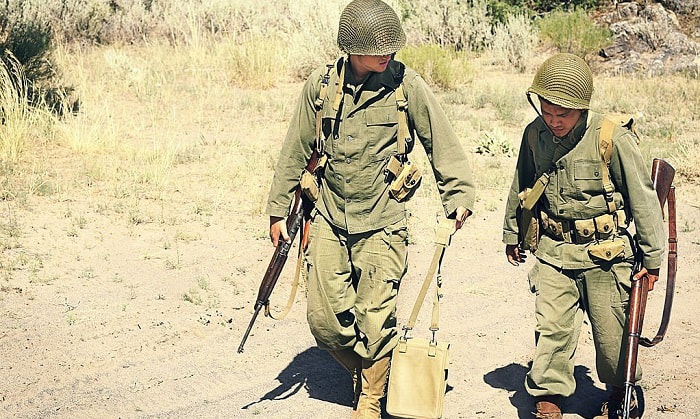The Vietnam War is a course that most schools teach. As such, the exam question, “Why did the United States send economic aid and military advisers to South Vietnam?” comes up frequently. Do you know the answer to this? No…?
Don’t worry! We have your back!
Today’s article will provide you the answer and some other relevant information. Keep reading!
Table of Contents
The Vietnam War (+ The U.S Involvement)
The Vietnam War lasted from November 1, 1955, to Apr 30, 1975. It is also commonly referred to as the Second Indochina War. The two “official” sides were North Vietnam and South Vietnam.
Belligerents on the North Vietnamese side (Viet Cong & PGR) included Pthet Lao, Khmer Rouge, GRUNK (1970-1975), China, Soviet Union, North Korea. They were supported by Bulgaria, Cuba, Czechoslovakia, East Germany, Hungary, Poland, Romania, and Sweden.
On the South Vietnamese side, belligerents were the U.S, South Korea, Australia, New Zealand, Laos, Cambodia, Khmer Republic, Thailand, and the Philippines, and they were supported by Malaysia and
Ultimately, the North Vietnamese (Viet Cong) won. The U.S coalition forces withdrew after the Paris Peace Accords in 1973 and communist forces took power in South Vietnam, Cambodia, and Laos. Vietnam reunified, but this kickstarted the refugee and boat people crises, as well as the Cambodian genocide and the Third Indochina War.
The U.S became involved in 1965 when the Marines landed near South Vietnam’s Da Nang. It was considered the start of the American ground war. The deployment included 3,500 Marines and was overwhelmingly supported by the U.S public. The 3,500 number soon increased to some 200,000 in 9 months.
The plan was:
- Phase 1 – Halt the South Vietnamese losing trend by the end of 1965
- Phase 2 – Destroy guerrilla and enemy forces and drive them back from the populated areas
- Phase 3 – Destroy the remaining enemy forces in remote base areas
The U.S called for its SEATO and NATO alliances to contribute troops. Australia, New Zealand, Thailand, the Philippines, and South Korea agreed to do so. But Canada and the UK declined.
One of the main ways the U.S supported South Vietnam was by sending them economic aid and military advisors. So, why did the United States send military advisers and economic aid to South Vietnam?
Why Did the United States Send Military Advisers and Economic Aid to South Vietnam
Economic aid and military advisors were sent to South Vietnam to arm the army and train them to use the American-made weapons and advise South Vietnamese leaders on military tactics.
However, these efforts were ultimately proved to be futile – the North Vietnamese won.
Starting in 1964, there were already growing anti-war movements, first from college campuses. In 1967, the National Mobilization Committee to End the War in Vietnam coalition was formed by anti-war activists. A lot of Vietnam veterans, like former Senator John Kerry, opposed the war when returning to the U.S.
National and international outrage broke after a series of events:
- The My Lai Massacre 1968
- A U.S Army unit raped and killed Vietnamese civilians
- The Green Beret Affair 1969
- 8 Special Forces soldiers were arrested for murdering a suspected double agent.
- The Leaking of Pentagon Papers
- A collection of public deceptions on the part of the U.S government.
- Eventually, this led to the collapse of the US morale. This was reflected in the enlist records:
- Only 2.5 percent selected infantry combat positions between 1969 and 1970
- ROTC enrollment dropped from 191,749 in 1966 to 72,459 by 1971
- The enrollment number was only 33,220 in 1974
Units started to go “sand-bagging,” which meant that they would go to the countryside and look for a site out of view to rest rather than doing what they were ordered to. They also radioed false coordinates and reports.
It was also very evident, by the end of the Battle of FSB Mary Ann in 1971, through the serious losses of U.S defenders.
Conclusion
Congrats! Now you know that the answer to, “Why did the United States send economic aid and military advisers to South Vietnam?” is to arm the army, train them to use the American-made weapons, and South Vietnamese leaders on military tactics.
Hopefully, you have picked up a lot of information from our article. If you have any other queries or thoughts, reach out to us in the comments!

I am Everett Bledsoe, taking on the responsibility of content producer for The Soldiers Project. My purpose in this project is to give honest reviews on the gear utilized and tested over time. Of course, you cannot go wrong when checking out our package of information and guide, too, as they come from reliable sources and years of experience.


